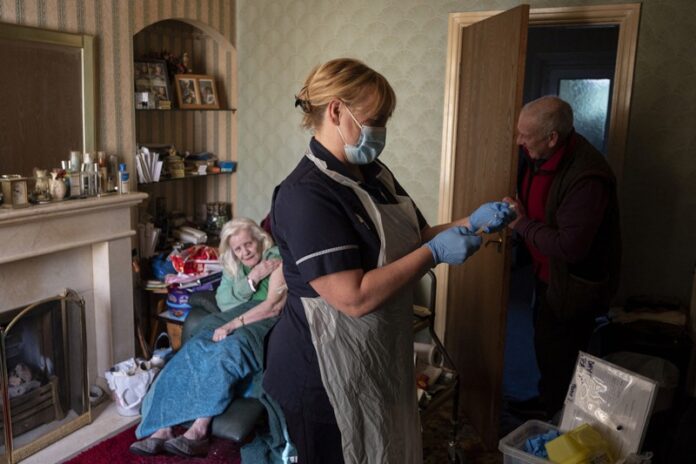New research by the Health Foundation’s Networked Data Lab (NDL) reveals the extent to which the pandemic has had a devastating and lasting impact on the more than four million people who were identified as being ‘clinically extremely vulnerable’ (CEV) and asked to shield*. The analysis suggests that there is now significant unmet health need and worsening mental health among this group. Based on the findings, the Health Foundation is calling for these patients to be prioritised by the NHS to ensure that that their conditions do not deteriorate further.
The analysis shows that clinically extremely vulnerable people experienced a higher rate of deaths compared to the general population over the pandemic. At the peak of the first wave (2 April 2020), the rate of deaths among the clinically vulnerable population was over two and half times that in the general population (1 in 2,500 or 0.039% compared to 1 in 7,000 or 0.014%). Furthermore, by the end of August 2020, the clinically extremely vulnerable population accounted for 19% of all deaths while only making up 4% of the total population in England.
However, as well as the direct impact of COVID-19, in terms of high rates of infections and deaths, clinically extremely vulnerable people have also been profoundly impacted by the major reorganisation of NHS services in the early stages of the pandemic. This was done to create capacity in order to care for COVID-19 patients and reduce infection risk in hospitals. However, as a result, planned admissions for clinically extremely vulnerable people decreased by 51% while outpatient appointments decreased by 48%. And although there was no intentional reorganisation of emergency care, emergency admissions for clinically extremely vulnerable people decreased by 32% from April 2019 to April 2020, while A&E attendances decreased by 42%.
Patterns of NHS use changed markedly across the whole population during the pandemic, but the higher reductions are particularly concerning because clinically extremely vulnerable people have a high level of health need and many require additional support compared to the general population. Unmet need and pent-up demand for NHS care that accumulated during the pandemic have now translated into record hospital waiting lists and a huge backlog of care. While those in the general population are also likely to be experiencing delays for treatment, the research suggests that there remains a particularly high level of unmet health need and potential-long term impacts concentrated within the clinically extremely vulnerable population.
The research also reveals that the clinically extremely vulnerable population may have significant unmet mental health needs, having experienced worsening mental health during the pandemic. For example, in Wales, after adjusting for age, sex, deprivation and history of mental ill health, clinically extremely vulnerable individuals were at increased risk of diagnosed depression and/or anxiety compared with the general population during the pandemic. From March to September 2020, 1 in 50 of clinically extremely vulnerable people in Wales were clinically recorded with depression and/or anxiety during shielding. Of those, 1 in 5 had no previous history of depression and/or anxiety. In Liverpool and Wirral, they found that compared with the general population, rates of antidepressant prescriptions were approximately 50% higher for the clinically extremely vulnerable cohort and that the increases in prescribing rates were also steeper.
Based on the findings, the Health Foundation says action is now needed by those planning the pandemic recovery at local and national level to better understand the needs of their clinically extremely vulnerable populations and ensure that their needs are prioritised.
The research also suggests that there were significant issues in the way that the shielding patient list was compiled. A centralised algorithmic approach was used nationally to identify clinically extremely vulnerable people, supplemented by local clinical judgement. The authors note that, while this did ensure some level of consistency between regions, there has been significant variation across the UK (the research covers England, Scotland and Wales) in terms of the numbers of people who have been added to the list. This is due to differences in how the list has been compiled in different areas of the country and the quality of data available. The authors say this raises questions about how effectively clinically extremely vulnerable people were identified and whether everyone had access to the support they required through the pandemic when they needed it. Those who weren’t identified would have missed out on vital support such as food parcels that were delivered to homes, priority delivery slots for online grocery shopping, and a medicine delivery service.
While the centralised algorithmic approach helped rapidly identify individuals, there are limitations to this approach which have been exacerbated by the poor availability of high-quality data in the NHS and social care. The authors say that greater access to data from general practice and better data sharing aids identification, and that investment in data sharing and data quality will be essential to improving the process. This is urgently needed to provide the NHS with a more accurate and complete picture of the needs of the clinically extremely vulnerable population so that services can be designed and delivered to meet these. But better data is also needed so that in the event of future pandemics, we can more effectively identify those at the highest risk of poor outcomes.
Kathryn Marszalek, Senior Analytical Manager at the Health Foundation, said:
‘Those who are clinically extremely vulnerable are, by definition, a high-risk group and the government took rapid steps to ensure that they would be protected during the pandemic. Despite this, they have seen worse rates of infection and death from COVID-19 and, having greater health care needs, have been particularly impacted by changes to NHS services during the pandemic. However, the negative impact goes beyond the harm to their physical health. Over a period of 10 months, those advised to isolate at home have been unable to take part in usual activities, such as shopping for food, exercising, or seeing friends and family. Our research reveals the toll this has taken on the mental wellbeing of many clinically extremely vulnerable people who were already more likely to suffer from mental health conditions than the general population.
‘Action is now needed by those planning the recovery at local and national levels to address the unmet need for NHS care and worsening mental health. Failure to prioritise the needs of the clinically extremely vulnerable population will inevitably result in further deterioration in their health, putting additional pressure on the NHS which is already struggling to deal with a massive backlog of care. Alongside this immediate support, further work is needed to understand the longer-term consequences for the clinically extremely vulnerable population, both in terms of long-term health care needs but also in terms of their ability to resume work and other daily activities. But this will be complicated by the current lack of high-quality data across the health and care systems. Further investment is urgently needed to ensure that in the event of a future health emergency, we can quickly, accurately and consistently identify individuals to enable rapid planning and delivery of relevant support.’







